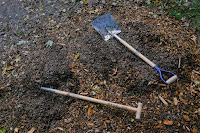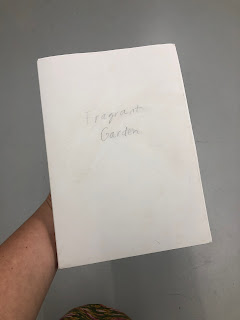While Guillem was away, Kate encountered some traces that probably suggested that someone had been sleeping at Shared Grounds.
The contents of two supermarket reusable bags were spread over the Gemeente mulch that now draws the path through the green strip. Cardboard packaging, reciepts, letter envelopes, instruction manuals, foam, broken branches, fallen leaves, broken lighters, clothing labels, a transport strap and a group of brown slugs enjpying the accumulated moisture inside one of the shopping bags.
By the shade of the "little house" (allegedly built by Stedin as their storage in the neighbourhood), we also found a "rent e-bike" lying on the ground as taking a nap.
In addition to all of these, we also encountered a considerable amount of human feces on the land, which we eventually spread to feed back into the soil community of the garden.
Encounering this traces made us remember about a time when we were first working on the locationa and a neighbour abruptly approached us questioning if we had been sleeping there since he heard noises thourghout the night. We explained him that we had been prunning a bit and showed him our gardening tools as proof of that. The behaviour and tone from the neighbour suggested us that there had been friction in the past between residents and people sleeping rough.
Someone sleeping at the garden posed quite a dilemma on us. But we were sure about one thing, we didn't want to involve any authority in dealing with this (we won't participate in homelessness criminalisation) and also, we didn't want to expose to an uncomfortable situation any participant/collaborator of the project nor the person/people who might have been using the land for sleeping.
To us, this situation is a very clear reminder that this garden is not only ours, and we never wanted it to be, as a public space in our city, the garden may serve the layered mulitiplicity of uses and interests of human and non-human agencies in the neighbourhood.
We reached out to our dear Four Siblings Collective for advice on the matter. They never had this situation on their land since they are quite outside the city area and there is almos nowhere to have privacy, it is like an open field. They also suggested to contact the "wijkagent" of Charlois, since they are not police but "a softer version for local and neibhourhood problems". They also suggested to contact the organisation We Are Here in case we met the person/people and they were to be refugees.
After giving it a lot of thought, we decided to let time pass and allow the garden to flow at its own rhythm.

































.jpeg)
.jpeg)
.jpeg)
.jpeg)
.jpeg)



.jpeg)


.jpeg)







